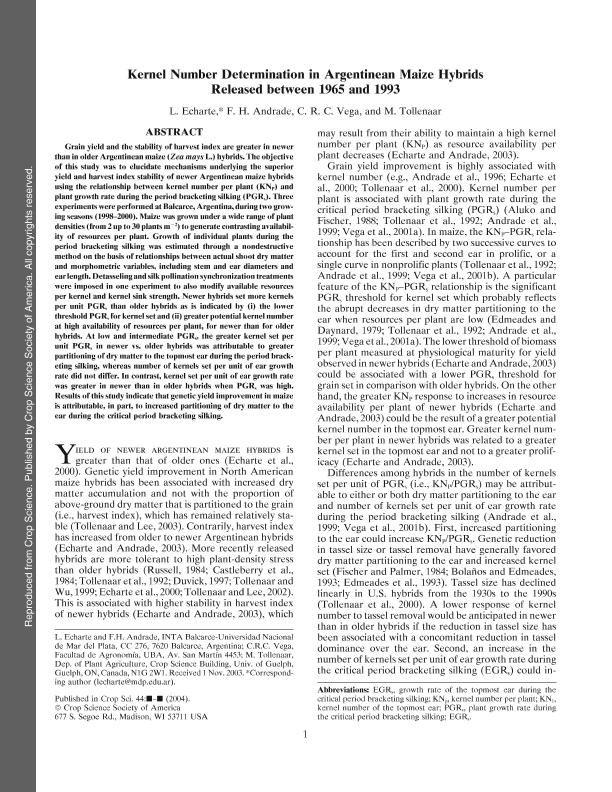Mostrar el registro sencillo del ítem
dc.contributor.author
Echarte, Maria Mercedes

dc.contributor.author
Andrade, Fernando Héctor

dc.contributor.author
Vega, Claudia Rosa Cecilia

dc.contributor.author
Tollenaar, M.
dc.date.available
2017-12-14T17:17:31Z
dc.date.issued
2004-01
dc.identifier.citation
Echarte, Maria Mercedes; Andrade, Fernando Héctor; Vega, Claudia Rosa Cecilia; Tollenaar, M.; Kernel number determination in argentinean maize hybrids released between 1965 and 1993.; Crop Science Society of America; Crop Science; 44; 1-2004; 1654-1661
dc.identifier.issn
0011-183X
dc.identifier.uri
http://hdl.handle.net/11336/30619
dc.description.abstract
Grain yield and the stability of harvest index are greater in newer than in older Argentinean maize (Zea mays L.) hybrids. The objective of this study was to elucidate mechanisms underlying the superior yield and harvest index stability of newer Argentinean maize hybrids using the relationship between kernel number per plant (KNP) and plant growth rate during the period bracketing silking (PGRs). Three experiments were performed at Balcarce, Argentina, during two growing seasons (1998–2000). Maize was grown under a wide range of plant densities (from 2 up to 30 plants m−2) to generate contrasting availability of resources per plant. Growth of individual plants during the period bracketing silking was estimated through a nondestructive method on the basis of relationships between actual shoot dry matter and morphometric variables, including stem and ear diameters and ear length. Detasseling and silk pollination synchronization treatments were imposed in one experiment to also modify available resources per kernel and kernel sink strength. Newer hybrids set more kernels per unit PGRs than older hybrids as is indicated by (i) the lower threshold PGRs for kernel set and (ii) greater potential kernel number at high availability of resources per plant, for newer than for older hybrids. At low and intermediate PGRs, the greater kernel set per unit PGRs in newer vs. older hybrids was attributable to greater partitioning of dry matter to the topmost ear during the period bracketing silking, whereas number of kernels set per unit of ear growth rate did not differ. In contrast, kernel set per unit of ear growth rate was greater in newer than in older hybrids when PGRs was high. Results of this study indicate that genetic yield improvement in maize is attributable, in part, to increased partitioning of dry matter to the ear during the critical period bracketing silking.
dc.format
application/pdf
dc.language.iso
eng
dc.publisher
Crop Science Society of America

dc.rights
info:eu-repo/semantics/openAccess
dc.rights.uri
https://creativecommons.org/licenses/by-nc-sa/2.5/ar/
dc.subject
Improvement
dc.subject
Genotype
dc.subject
Yield
dc.subject
Traits
dc.subject.classification
Agricultura

dc.subject.classification
Agricultura, Silvicultura y Pesca

dc.subject.classification
CIENCIAS AGRÍCOLAS

dc.title
Kernel number determination in argentinean maize hybrids released between 1965 and 1993.
dc.type
info:eu-repo/semantics/article
dc.type
info:ar-repo/semantics/artículo
dc.type
info:eu-repo/semantics/publishedVersion
dc.date.updated
2017-11-24T14:07:49Z
dc.journal.volume
44
dc.journal.pagination
1654-1661
dc.journal.pais
Estados Unidos

dc.journal.ciudad
Baltimore
dc.description.fil
Fil: Echarte, Maria Mercedes. Instituto Nacional de Tecnología Agropecuaria; Argentina. Consejo Nacional de Investigaciones Científicas y Técnicas; Argentina
dc.description.fil
Fil: Andrade, Fernando Héctor. Instituto Nacional de Tecnología Agropecuaria; Argentina
dc.description.fil
Fil: Vega, Claudia Rosa Cecilia. Universidad de Buenos Aires. Facultad de Agronomía; Argentina. Consejo Nacional de Investigaciones Científicas y Técnicas; Argentina
dc.description.fil
Fil: Tollenaar, M.. University of Guelph; Canadá
dc.journal.title
Crop Science

dc.relation.alternativeid
info:eu-repo/semantics/altIdentifier/doi/http://dx.doi.org/10.2135/cropsci2004.1654
Archivos asociados
